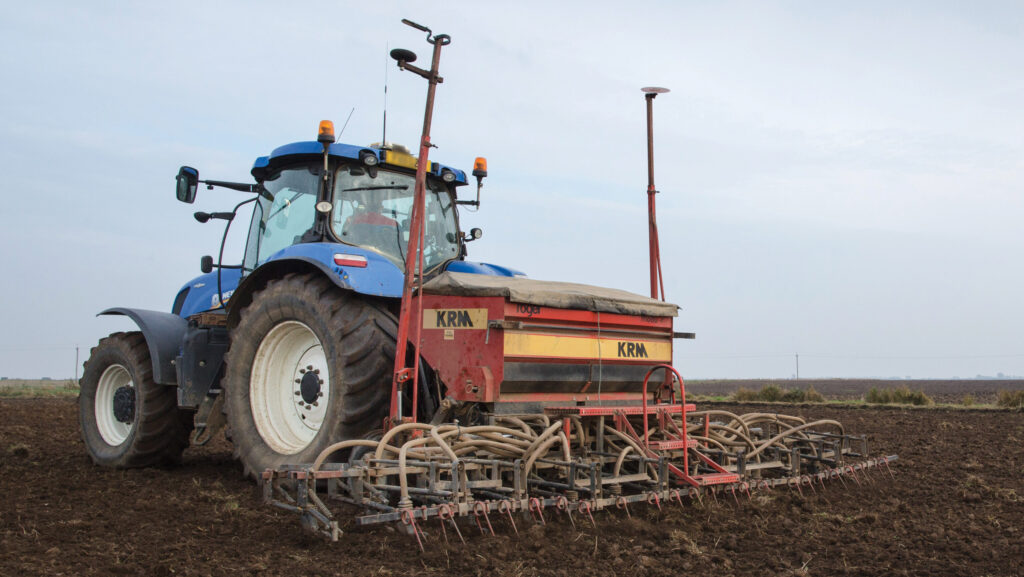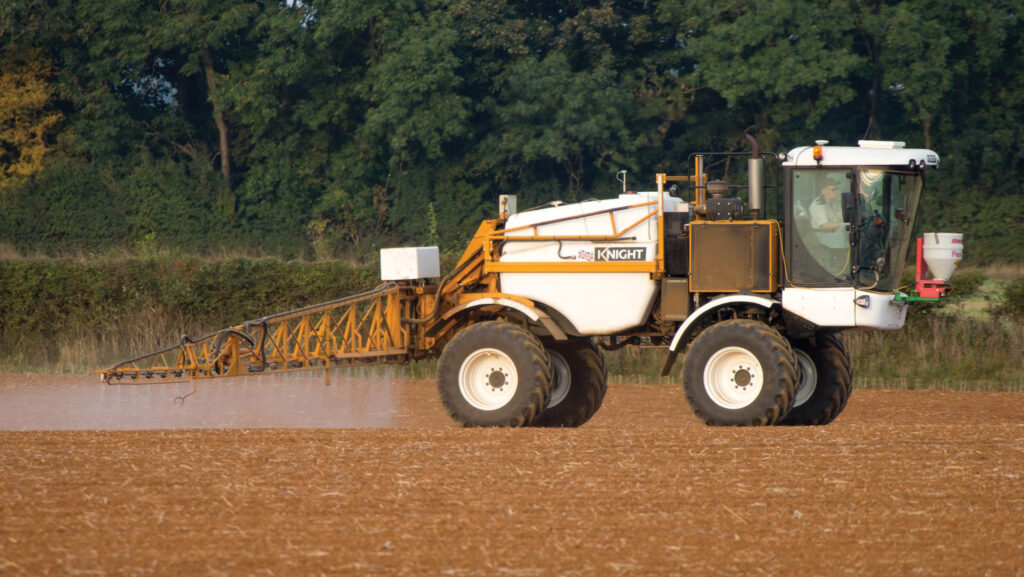Crop Watch: Agronomist views on the 2024 drilling campaign
 © Tim Scrivener
© Tim Scrivener Farmers Weekly’s Crop Watch columnists are back for another season, providing their latest insights and advice to a range of agronomy practices across the UK.
Here we find out how a wet start to the autumn is affecting the drilling campaign.
See also: Cereal seed treatments for farmers to consider this autumn
South
Justin Smith
Procam (East Sussex)
American rock band Green Day have a song entitled “Wake Me Up When September Ends”. It has never seemed more appropriate.
At least the early drilling conundrum has been taken care of for us in the South East.
The 3.5in of rain falling over a 72-hour period saw any valiant efforts for early drilling disappear in a mound of tacky Weald clay.
Although harvest 2024 probably won’t set any records, it certainly wasn’t as disastrous as I first feared.
With many having to adapt to spring crops, the continuing moisture throughout the key growth stages meant these seemed to fair well overall.
For this autumn, continuing discussions surrounding Sustainable Farming Incentive options have enabled some decisions to be made.
On reflection, to not drill a harvestable crop in some instances and instead opt for a short- or medium-term stewardship option is probably equally as lucrative – with the caveat that should not jeopardise the long-term farming strategy or undo the good foundations of previous rotations and weed control.
As we now hopefully embark on the more traditional October drilling campaigns, I remain fairly optimistic for several reasons:
- The higher-risk September drilling windows were few
- Moisture is readily present for both the effective use of stale seed-beds and pre-emergence herbicides
- Overall expenditure should decrease the later you drill
- We now know how to adapt to these situations and, of late, have become masters at it.
Embrace change; sometimes that may mean going back to things you had previously discredited, such as spring cropping or ploughing, but never fear judgement or prejudice.
We know you can’t beat Mother Nature, but if you plan for the worst, you can usually weather the storm.
East
Ryan Baker
Frontier (Suffolk/Norfolk)
Despite the best restraint, and with last autumn still fresh in the mind, the drills are rolling. A large proportion of winter barley has been drilled into very respectable seed-beds.
Drilling wheat on lighter and cleaner blackgrass land is also under way.
However, blackgrass emergence has been slow; even on land cultivated in early August blackgrass is only just starting to emerge.
Recent rain has encouraged those with the worst blackgrass burden to wait for a further flush, to spray off ahead of drilling.
Significant soil moisture in the spring, coinciding with the peak slug breeding season, means caution is required this autumn.
Higher seed rates can help compensate for slug damage as well as increase competitiveness against blackgrass.
Quality of seed-beds, rolling, and an appropriate consideration of crop residues are fundamental to the integrated management of the slug population before turning to ferric phosphate.
Lessons learned from last season mean care and attention should be applied to seed depth and coverage.
Flufenacet-based programmes provide a cost-effective base for meadow grass and fields with low blackgrass pressure. For higher pressure situations, Cinmethylin is still the standout active ingredient.
Slugs have also provided a challenge for young oilseed rape plants. Early established plants that were drilled into moisture have got away well.
Those fields drilled in the middle of the planting window have suffered with the worst cabbage stem flea beetle pressure.
Later crops are now at two to three true leaves and every seed appears to have grown. Similar to stale seed-beds, blackgrass in oilseed rape fields is only just starting to emerge.
For the best efficacy from clethodim, blackgrass needs to be at two to three true leaves and actively growing.
Clethodim stewardship requires this application to be before 15 October and six true leaves.
Crops established with more intensive cultivations now have a higher broad-leaved weed population.
Residuals can still be applied if the weeds are smaller, but now that 15 September has passed, a single application of Belkar (Arylex) can be used effectively.
Several fields of sugar beet have now been lifted to allow early establishment of following crops.
Yields have been moderate but average sugars have been just over 17%, with 20% being the highest recorded so far.
For those fields being lifted after Christmas, now is the time to assess the requirement for a third fungicide application.
West
Dominic Edmond
Matford Arable (Devon/Cornwall)
As this is my first Crop Watch report, I thought I’d give you some background.
At 55 (photos do lie), I have worked for Matford Arable Systems (MAS) for 27 years as an agronomist.
Before that, I had two stints at college, studying a diploma in agriculture and a degree in rural resource management.
My working life in and around college involved milking and livestock work and spending seven seasons on an arable farm in Hertfordshire, managing a grain store and combining – which is where my interest in crop production began.
As an agronomist for MAS, I cover quite a wide geographical area. My home is near Exeter, and I cover east and south Devon, a little of north Devon, north Cornwall and as far west as the Lizard peninsula.
The areas come with a variety of soil types, topography and weather patterns and a variety of crops including winter wheat, barley and oats, spring barley and oats, OSR, beans, maize, fodder beet and grass.
The harvesting of spring crops this season has just about been completed in the past three weeks – bar some spring beans that were drilled late.
Harvest was a catchy affair, with weather conditions proving challenging. Yields of oilseed rape were variable.
Winter barley crops were average to good, with some poor crops in fields that suffered in the weather.
Wheat in some areas of Devon performed better than expected, but after a year with high septoria tritici levels and spray timings under pressure due to limited spray days, some wheats were very average.
Spring barley faired reasonably well this year, which was needed after last year.
As I write, some early drilled maize crops in favourable areas have been harvested but there are large acreages of maize that are still to be harvested and are two to four weeks away and need favourable weather conditions to ensure speedy ripening.
With such wet autumns in 2022 and 2023, there is a growing concern over drilling opportunities going forward.
In a perfect world the weather would play ball and allow drilling to commence in a weeks’ time and provide a three- to four-week window to allow the application of pre-emergence herbicides and timely barley yellow dwarf virus sprays.
Hopefully, I can report that this was the case in my next column.

© Tim Scrivener
North
Mary Munro
Munro Agricultural Consultancy
Harvest is drawing to a close north of the border, and in East Lothian there are a few fields of spring beans left to cut, but not much else for the combines.
Potato lifting will last another month or so. All growers will be glad to see the back of the 2023-24 season, and I certainly hope we don’t get another one like it for a long time.
Yields were average at best, with one or two outliers doing well, but no surprises. Weak prices added insult to injury.
Moving swiftly on, I have taken the plunge and started my own business, which is a fresh start for a new season and, so far, very satisfying and rewarding.
Oilseed rape crops are looking really good, and we had no worries with cabbage stem flea beetle this year.
The herbicides are on and volunteer cereals slowly dying off.
I am changing tactics this year and have gone with metazachlor plus graminicide early post-emergence, and will follow with Belkar (Arylex).
Kerb (propyzamide) still has an important role in the programme for most situations. Drilling is well under way with some wheat, barley and oats now in the ground.
There is some move to newer wheat varieties such as Blackstone and Bamford, and it will be interesting to see how they perform on my clients’ farms.
Sowing is later than I would like, but the weather has dictated the pace.
There is a huge choice of autumn herbicides but for most I will go with a good generic Liberator (flufenacet plus diflufenican) with a Pico product (picolinafen plus pendimethalin) on wheat, and either that or a Tower-type option on winter barley (chlortoluron + DFF + PDM).
These provide a bit of flexibility as they can go on pre- or post-emergence, which saves a lot of hassle, while still doing a good job.
Brome and annual meadow grass are the main targets, and it is good to deal with any autumn-germinating broad-leaved weeds at the same time.
There are ominous rumblings about flufenacet being withdrawn in the foreseeable future.
In that case the Tower/Tribal option may be in demand, and we now have the Luximo products for wheat, so hopefully there will be sufficient alternatives available.

